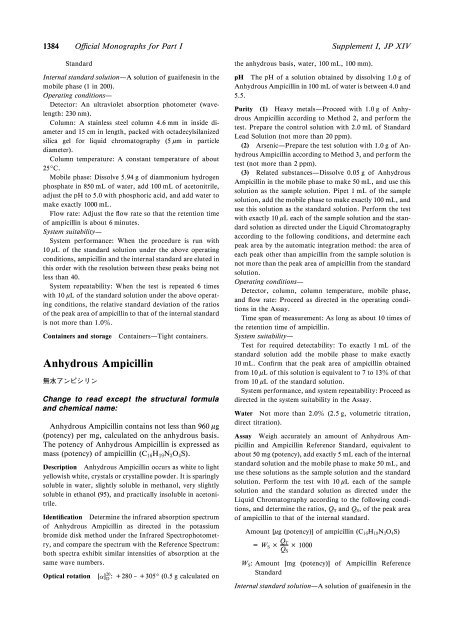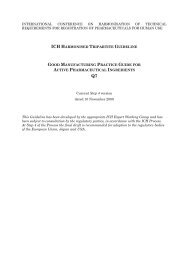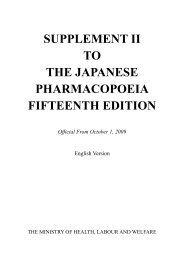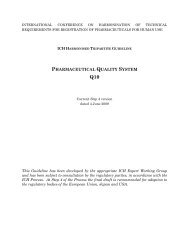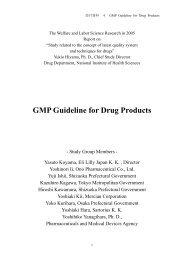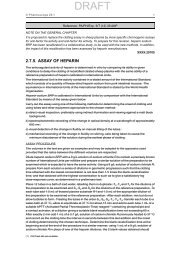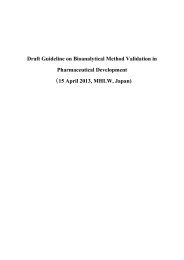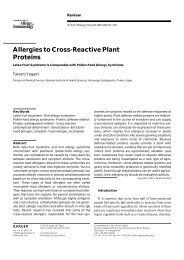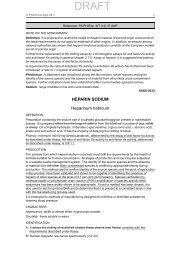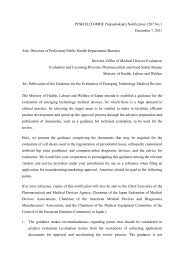Supplement I to the Japanese Pharmacopoeia Fourteenth Edition
Supplement I to the Japanese Pharmacopoeia Fourteenth Edition
Supplement I to the Japanese Pharmacopoeia Fourteenth Edition
You also want an ePaper? Increase the reach of your titles
YUMPU automatically turns print PDFs into web optimized ePapers that Google loves.
1384 O‹cial Monographs for Part I<br />
<strong>Supplement</strong> I, JP XIV<br />
Standard<br />
Internal standard solution—A solution of guaifenesin in <strong>the</strong><br />
mobile phase (1 in 200).<br />
Operating conditions—<br />
Detec<strong>to</strong>r: An ultraviolet absorption pho<strong>to</strong>meter (wavelength:<br />
230 nm).<br />
Column: A stainless steel column 4.6 mm in inside diameter<br />
and 15 cm in length, packed with octadecylsilanized<br />
silica gel for liquid chroma<strong>to</strong>graphy (5 mm in particle<br />
diameter).<br />
Column temperature: A constant temperature of about<br />
259C.<br />
Mobile phase: Dissolve 5.94 g of diammonium hydrogen<br />
phosphate in 850 mL of water, add 100 mL of ace<strong>to</strong>nitrile,<br />
adjust <strong>the</strong> pH <strong>to</strong> 5.0 with phosphoric acid, and add water <strong>to</strong><br />
make exactly 1000 mL.<br />
Flow rate: Adjust <strong>the</strong> ‰ow rate so that <strong>the</strong> retention time<br />
of ampicillin is about 6 minutes.<br />
System suitability—<br />
System performance: When <strong>the</strong> procedure is run with<br />
10 mL of <strong>the</strong> standard solution under <strong>the</strong> above operating<br />
conditions, ampicillin and <strong>the</strong> internal standard are eluted in<br />
this order with <strong>the</strong> resolution between <strong>the</strong>se peaks being not<br />
less than 40.<br />
System repeatability: When <strong>the</strong> test is repeated 6 times<br />
with 10 mL of <strong>the</strong> standard solution under <strong>the</strong> above operating<br />
conditions, <strong>the</strong> relative standard deviation of <strong>the</strong> ratios<br />
of <strong>the</strong> peak area of ampicillin <strong>to</strong> that of <strong>the</strong> internal standard<br />
is not more than 1.0z.<br />
Containers and s<strong>to</strong>rage<br />
Anhydrous Ampicillin<br />
無 水 アンピシリン<br />
Containers—Tight containers.<br />
Change <strong>to</strong> read except <strong>the</strong> structural formula<br />
and chemical name:<br />
Anhydrous Ampicillin contains not less than 960 mg<br />
(potency) per mg, calculated on <strong>the</strong> anhydrous basis.<br />
The potency of Anhydrous Ampicillin is expressed as<br />
mass (potency) of ampicillin (C 16 H 19 N 3 O 4 S).<br />
Description Anhydrous Ampicillin occurs as white <strong>to</strong> light<br />
yellowish white, crystals or crystalline powder. It is sparingly<br />
soluble in water, slightly soluble in methanol, very slightly<br />
soluble in ethanol (95), and practically insoluble in ace<strong>to</strong>nitrile.<br />
Identiˆcation Determine <strong>the</strong> infrared absorption spectrum<br />
of Anhydrous Ampicillin as directed in <strong>the</strong> potassium<br />
bromide disk method under <strong>the</strong> Infrared Spectropho<strong>to</strong>metry,<br />
and compare <strong>the</strong> spectrum with <strong>the</strong> Reference Spectrum:<br />
both spectra exhibit similar intensities of absorption at <strong>the</strong><br />
same wave numbers.<br />
<strong>the</strong><br />
Optical rotation [a] 20<br />
D : +280 – +3059(0.5 g calculated on<br />
anhydrous basis, water, 100 mL, 100 mm).<br />
pH The pH of a solution obtained by dissolving 1.0 g of<br />
Anhydrous Ampicillin in 100 mL of water is between 4.0 and<br />
5.5.<br />
Purity (1) Heavy metals—Proceed with 1.0 g of Anhydrous<br />
Ampicillin according <strong>to</strong> Method 2, and perform <strong>the</strong><br />
test. Prepare <strong>the</strong> control solution with 2.0 mL of Standard<br />
Lead Solution (not more than 20 ppm).<br />
(2) Arsenic—Prepare <strong>the</strong> test solution with 1.0 g of Anhydrous<br />
Ampicillin according <strong>to</strong> Method 3, and perform <strong>the</strong><br />
test (not more than 2 ppm).<br />
(3) Related substances—Dissolve 0.05 g of Anhydrous<br />
Ampicillin in <strong>the</strong> mobile phase <strong>to</strong> make 50 mL, and use this<br />
solution as <strong>the</strong> sample solution. Pipet 1 mL of <strong>the</strong> sample<br />
solution, add <strong>the</strong> mobile phase <strong>to</strong> make exactly 100 mL, and<br />
use this solution as <strong>the</strong> standard solution. Perform <strong>the</strong> test<br />
with exactly 10 mL each of <strong>the</strong> sample solution and <strong>the</strong> standard<br />
solution as directed under <strong>the</strong> Liquid Chroma<strong>to</strong>graphy<br />
according <strong>to</strong> <strong>the</strong> following conditions, and determine each<br />
peak area by <strong>the</strong> au<strong>to</strong>matic integration method: <strong>the</strong> area of<br />
each peak o<strong>the</strong>r than ampicillin from <strong>the</strong> sample solution is<br />
not more than <strong>the</strong> peak area of ampicillin from <strong>the</strong> standard<br />
solution.<br />
Operating conditions—<br />
Detec<strong>to</strong>r, column, column temperature, mobile phase,<br />
and ‰ow rate: Proceed as directed in <strong>the</strong> operating conditions<br />
in <strong>the</strong> Assay.<br />
Time span of measurement: As long as about 10 times of<br />
<strong>the</strong> retention time of ampicillin.<br />
System suitability—<br />
Test for required detectability: To exactly 1 mL of <strong>the</strong><br />
standard solution add <strong>the</strong> mobile phase <strong>to</strong> make exactly<br />
10 mL. Conˆrm that <strong>the</strong> peak area of ampicillin obtained<br />
from 10 mL of this solution is equivalent <strong>to</strong> 7 <strong>to</strong> 13z of that<br />
from 10 mL of <strong>the</strong> standard solution.<br />
System performance, and system repeatability: Proceed as<br />
directed in <strong>the</strong> system suitability in <strong>the</strong> Assay.<br />
Water Not more than 2.0z (2.5 g, volumetric titration,<br />
direct titration).<br />
Assay Weigh accurately an amount of Anhydrous Ampicillin<br />
and Ampicillin Reference Standard, equivalent <strong>to</strong><br />
about 50 mg (potency), add exactly 5 mL each of <strong>the</strong> internal<br />
standard solution and <strong>the</strong> mobile phase <strong>to</strong> make 50 mL, and<br />
use <strong>the</strong>se solutions as <strong>the</strong> sample solution and <strong>the</strong> standard<br />
solution. Perform <strong>the</strong> test with 10 mL eachof<strong>the</strong>sample<br />
solution and <strong>the</strong> standard solution as directed under <strong>the</strong><br />
Liquid Chroma<strong>to</strong>graphy according <strong>to</strong> <strong>the</strong> following conditions,<br />
and determine <strong>the</strong> ratios, Q T and Q S , of <strong>the</strong> peak area<br />
of ampicillin <strong>to</strong> that of <strong>the</strong> internal standard.<br />
Amount [mg (potency)] of ampicillin (C 16 H 19 N 3 O 4 S)<br />
= W S × Q T<br />
Q S<br />
× 1000<br />
W S : Amount [mg (potency)] of Ampicillin Reference<br />
Standard<br />
Internal standard solution—A solution of guaifenesin in <strong>the</strong>


